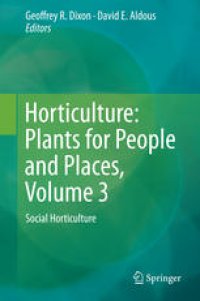
Ebook: Horticulture: Plants for People and Places, Volume 3: Social Horticulture
- Tags: Agriculture, Food Science, Environment general, Business/Management Science general, Social Sciences general, Humanities general
- Year: 2014
- Publisher: Springer Netherlands
- Edition: 1
- Language: English
- pdf
This Trilogy explains “What is Horticulture?”. Volume three of Horticulture: Plants for People and Places presents readers with detailed accounts of the scientific and scholastic concepts which interact with the arts and humanities and which now underpins the rapidly evolving subject of Social Horticulture. This discipline transcends the barriers between science, medicine and the arts. This volume covers:- Horticulture and Society, Diet and Health, Psychological Health, Wildlife, Horticulture and Public Welfare, Education, Extension, Economics, Exports and Biosecurity, Scholarship and Art, Scholarship and Literature, Scholarship and History and the relationship between Horticulture and Gardening. This volume brings the evolution of the Discipline and Vocation of Horticulture firmly into the 21st Century. It covers new ground by providing a detailed analysis of the value of Horticulture as a force for enhancing society in the forms of social welfare, health and well-being, how knowledge is transferred within and between generations, and the place of Horticulture in the Arts and Humanities. Substantial emphasis is given to the relationships between health, well-being and plants by the internationally acclaimed authors who have contributed accounts of their work in this book.
Volume three of Horticulture – Plants for People and Places analyses in depth the scientific and scholastic concepts interacting with the arts, medicine and humanities which now underpin the rapidly evolving subject of Social Horticulture. This covers: Horticulture and Society, Diet and Health, Psychological Health, Wildlife, Horticulture and Public Welfare, Education, Extension, Economics, Exports and Biosecurity, Scholarship and Art, Scholarship and Literature, Scholarship and History and the relationship between Horticulture and Gardening. This volume takes the evolution of this Discipline firmly into the 21st Century. It breaks new ground by providing a detailed analysis of the value of Horticulture as a force for enhancing society in the form of human welfare, health and well-being. The authors consider how knowledge is transferred within and between generations, and the place of Horticulture in the Arts and Humanities. These studies transcend the barriers between science and the arts. Social benefits of an association with plants include reducing the potential for domestic violence, vandalism, ethnic conflict and crime by building interpersonal social relationships and networks. Two chapters examine the means by which knowledge is delivered and the wider contexts within which Horticultural Education is provided. Understanding the Economics of Horticulture is of paramount importance in justifying public and private financial provisions for the discipline. Biosecurity is not easily achieved because global travel takes new plants, microbes and animals around the world at ever increasing speed. Of particular significance in this volume are the three chapters dealing with aspects of the relationship between Horticulture and scholarship embracing art, literature and history. This is an ancient relationship where Horticultural Science unites with and demonstrates its artistic and historical credentials. Finally, there is an examination of the relationship between Horticulture and Gardening. Culturally gardening has much to do with the relationship between man, plants and the human spirit. It is a truism that “Horticulture is to English Literature as Gardening is to Theatre”. This book is a sign post for the future of Social Horticulture.